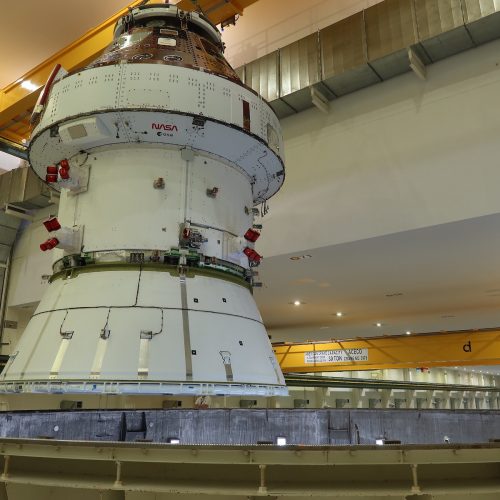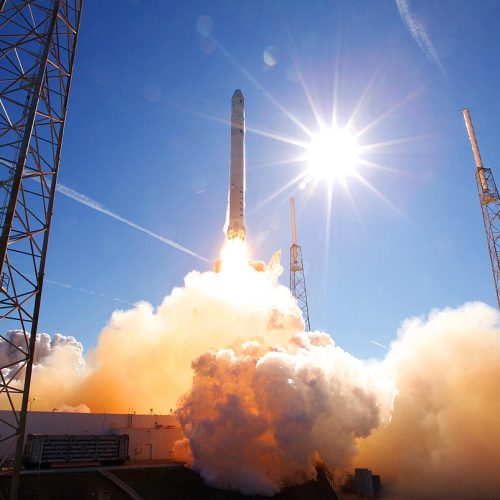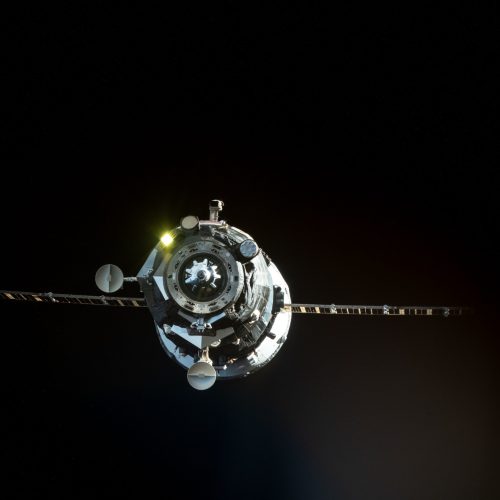How NASA Might Change Under Donald Trump


Although the details remain in flux, the transition team reviewing NASA and its activities has begun to draft potential executive orders for changes to space policy under the Trump Administration.
Sources familiar with the five people on the team, who have spent the last six weeks assessing the space agency and its exploration plans, were careful to note that such teams are advisory in nature. They do not formally set policy nor is their work always indicative of the direction an incoming presidential administration will move toward.
Nevertheless, in trying to set clear goals for NASA and civil space policy, the ideas under consideration reflect the Trump administration's desire for "big changes" at NASA, both in terms of increasing the effectiveness and velocity of its programs.


© NASA

Almost no one ever writes about the Parker Solar Probe anymore.
Sure, the spacecraft got some attention when it launched. It is, after all, the fastest moving object that humans have ever built. At its maximum speed, goosed by the gravitational pull of the Sun, the probe reaches a velocity of 430,000 miles per hour, or more than one-sixth of 1 percent the speed of light. That kind of speed would get you from New York City to Tokyo in less than a minute.
And the Parker Solar Probe also has the distinction of being the first NASA spacecraft named after a living person. At the time of its launch, in August 2018, physicist Eugene Parker was 91 years old.


© NASA/Aurich Lawson
In a widely anticipated test, Blue Origin may ignite the seven main engines on its New Glenn rocket as soon as Thursday at Launch Complex-36 in Florida.
This is the final test the company must complete before verifying the massive rocket is ready for its debut flight, and it is the most dynamic. This will be the first time Blue Origin has ever test-fired the BE-7 engines altogether, in a final rehearsal before launch.
The company did not respond immediately to a request for comment, but the imminent nature of the test was confirmed by a NASA official.


© Blue Origin
In a wide-ranging interview with a Russian television station, the chief executive of Russia's main space corporation said the country is now planning to participate in the International Space Station project all the way to NASA's desired goal of 2030.
"In coordination with our American colleagues, we plan to de-orbit the station sometime around the beginning of 2030," the country's chief space official, Yuri Borisov, said during the interview. "The final scenario will probably be specified after the transition to a new NASA administration."
While the documents for such an extension have not been signed, these comments appear to represent a change in tone from Russia. When he first became head of Roscosmos in 2022, Borisov said Russia would leave the station partnership "after" 2024, which was interpreted as shortly thereafter. Later, Russia committed to working with NASA to keep the orbital outpost flying only through 2028. The US space agency has expressed a consistent desire to keep flying the station until 2030, after which point it hopes that private space station operators can provide one or more replacement facilities.


© MIKHAIL METZEL/POOL/AFP via Getty Images
A new investigation from The New York Times suggests that SpaceX founder Elon Musk has not been reporting his travel activities and other information to the Department of Defense as required by his top-secret clearance.
According to the newspaper, concerns about Musk's reporting practices have led to reviews by three different bodies within the military; the Air Force, the Office of the Under Secretary of Defense for Intelligence and Security, and the Defense Department Office of Inspector General.
However, none of the federal agencies cited in the Times article has accused Musk of disclosing classified material.


© Brandon Bell/Getty Images
Welcome to Edition 7.23 of the Rocket Report! We're closing in on the end of the year, with a little less than three weeks remaining in 2024. Can you believe it? I hardly can. The biggest question left in launch is whether Blue Origin will make its deadline for launching New Glenn by the end of this year. It's been a long-time goal of founder Jeff Bezos, but the clock is ticking. We wish them luck!
As always, we welcome reader submissions, and if you don't want to miss an issue, please subscribe using the box below (the form will not appear on AMP-enabled versions of the site). Each report will include information on small-, medium-, and heavy-lift rockets as well as a quick look ahead at the next three launches on the calendar.

Virgin Galactic studies Italian spaceport. The US-based suborbital space tourism company said Thursday it has signed an "agreement of cooperation" with Italy's civil aviation authority to study the feasibility of Virgin Galactic conducting spaceflight operations from Grottaglie Spaceport in the Puglia region of Southern Italy. Phase one of the study, anticipated to be completed in 2025, will examine Grottaglie’s airspace compatibility with Virgin Galactic’s requirements and unique flight profile.


© SpaceX
In recent days, there has been a smattering of coverage in state-run Russian media outlets about how the Belarusian army has developed its own satellite Internet service akin to SpaceX's Starlink constellation, called "Kulisa."
According to the TASS news service, for example, the Kulisa mobile communications technology has "already entered service and is being used in military units of the Armed Forces."
And Pravda, which started out as the official newspaper of Russia's Communist Party more than a century ago, taunted the developer of the technology, saying, "How's that for you, SpaceX?"


© Pravda
Eleven months after the Ingenuity helicopter made its final flight on Mars, engineers and scientists at NASA and a private company that helped build the flying vehicle said they have identified what probably caused it to crash on the surface of Mars.
In short, the helicopter's on-board navigation sensors were unable to discern enough features in the relatively smooth surface of Mars to determine its position, so when it touched down, it did so moving horizontally. This caused the vehicle to tumble, snapping off all four of the helicopter's blades.
It is not easy to conduct a forensic analysis like this on Mars, which is typically about 100 million miles from Earth. Ingenuity carried no black box on board, so investigators have had to piece together their findings from limited data and imagery.


© NASA/JPL-Caltech/LANL/CNES/CNRS
There is, of course, no quantitative way to rank amazing things that happen in space. We cannot measure their absolute magnitude nor assign them a numerical value, and trying to do so is something of a fool’s errand. Are we fools? Maybe. But we're fools who like to have a little fun.
Understandably, then, this list is completely subjective. How else could one rank events that span the cosmos, from gravitational wave detection to the launch of humans into suborbital space? What follows is a list of the most incredible, surprising, impressive, and demanding achievements and developments in space and spaceflight during the first 25 years of the 2000s—as selected by the editors of Ars Technica.
You will probably disagree with some choices and their ranking, and that’s totally fine. That’s what the comments section is for. But the point here is simply to bring some of these incredible moments back onto the front burner so we can all bask in their glory once again. Each of these achievements deserves our celebration and appreciation.


© ESA
Blue Origin said Tuesday that the test payload for the first launch of its new rocket, New Glenn, is ready for liftoff. The company published an image of the "Blue Ring" pathfinder nestled up against one half of the rocket's payload fairing.
"There is a growing demand to quickly move and position equipment and infrastructure in multiple orbits," the company's chief executive, Dave Limp, said on LinkedIn. "Blue Ring has advanced propulsion and communication capabilities for government and commercial customers to handle these maneuvers precisely and efficiently."
This week's announcement—historically Blue Origin has been tight-lipped about new products, but is opening up more as it nears the debut of its flagship New Glenn rocket—appears to serve a couple of purposes.


© Blue Origin
Within hours of NASA announcing its decision to fly the Artemis II mission aboard an Orion spacecraft with an unmodified heat shield, critics assailed the space agency, saying it had made the wrong decision.
"Expediency won over safety and good materials science and engineering. Sad day for NASA," Ed Pope, an expert in advanced materials and heat shields, wrote on LinkedIn.
There is a lot riding on NASA's decision, as the Artemis II mission involves four astronauts and the space agency's first crewed mission into deep space in more than 50 years.


© NASA/Amanda Stevenson
Welcome to Edition 7.22 of the Rocket Report! The big news is the Trump administration's announcement that commercial astronaut Jared Isaacman would be put forward as the nominee to serve as the next NASA Administrator. Isaacman has flown to space twice, and demonstrated that he takes spaceflight seriously. More background on Isaacman, and possible changes, can be found here.
As always, we welcome reader submissions, and if you don't want to miss an issue, please subscribe using the box below (the form will not appear on AMP-enabled versions of the site). Each report will include information on small-, medium-, and heavy-lift rockets as well as a quick look ahead at the next three launches on the calendar.

Orbex pauses launch site work in Sutherland, Scotland. Small-launch vehicle developer Orbex will halt work on its own launch site in northern Scotland and instead use a rival facility in the Shetland Islands, Space News reports. Orbex announced December 4 that it would "pause" construction of Sutherland Spaceport in Scotland and instead use the SaxaVord Spaceport on the island of Unst in the Shetlands for its Prime launch vehicle. Orbex had been linked to Spaceport Sutherland since the UK Space Agency announced in 2018 it selected the site for a vertical launch complex.


© SpaceX
President-elect Donald Trump announced Wednesday his intent to nominate entrepreneur and commercial astronaut Jared Isaacman as the next administrator of NASA.
For those unfamiliar with Isaacman, who at just 16 years old founded a payment processing company in his parents' basement that ultimately became a major player in online payments, it may seem an odd choice. However, those inside the space community welcomed the news, with figures across the political spectrum hailing Isaacman's nomination variously as "terrific," "ideal," and "inspiring."
This statement from Isaac Arthur, president of the National Space Society, is characteristic of the response: "Jared is a remarkable individual and a perfect pick for NASA Administrator. He brings a wealth of experience in entrepreneurial enterprise as well as unique knowledge in working with both NASA and SpaceX, a perfect combination as we enter a new era of increased cooperation between NASA and commercial spaceflight."


© SpaceX
Oh, Enron, I thought—hoped and dreamed?—you were long, long gone, confined to the dustbin of history reserved for seriously fraudulent companies.
But apparently not.
More than two decades after Enron's bankruptcy in December 2001, the company is back. Well, at least an entity using the website Enron.com went public on Monday, announcing Enron's relaunch as "a company dedicated to solving the global energy crisis."


© James Nielsen/Getty Images
SpaceX recently hit some notable milestones with its workhorse Falcon 9 rocket, and even in the full context of history, the performance of the vehicle is pretty incredible.
Last Tuesday, the company launched a batch of Starlink v2-mini satellites from Kennedy Space Center in Florida on a Falcon 9 rocket, marking the 400th successful mission by the Falcon 9 rocket. Additionally, it was the Falcon program's 375th booster recovery, according to SpaceX. Finally, with this mission, the company shattered its record for turnaround time from the landing of a booster to its launch to 13 days and 12 hours, down from 21 days.
But even though it was mere hours before the Thanksgiving holiday in the United States, SpaceX was not done for the month. On Saturday, November 30, the company launched twice more in a little more than three hours. The payloads were more Starlink Internet satellites in addition to two Starshield satellites—a custom version of Starlink for the US Department of Defense—for the US military.


© SpaceX
It should have been a routine mission to ferry about three tons of food, fuel, and supplies to the International Space Station, but when Russian cosmonauts opened the hatch to a cargo spacecraft on Saturday, they got a surprise—a toxic smell.
"After opening the Progress spacecraft's hatch, the Roscosmos cosmonauts noticed an unexpected odor and observed small droplets, prompting the crew to close the Poisk hatch to the rest of the Russian segment," NASA said in a statement on Sunday.
According to the space agency, air scrubbers and contaminant sensors on board the orbiting laboratory monitored the station’s atmosphere following the observation of the aberrant smell. By Sunday, flight controllers in Mission Control in Houston determined air quality inside the space station was at normal levels.


© NASA
It would be easy to be cynical about a German-French startup named The Exploration Company, which aims to build an increasingly sophisticated lineup of spaceships that could one day launch astronauts into orbit.
After all, European space startups don't have the greatest track record, and even with billions of dollars, one of the world's leading aerospace companies, Boeing, has failed so far to deliver a fully space-worthy human vehicle. Space is hard; human spaceflight is harder. So when a European startup shows up with grandiose plans, one's natural inclination might be to dismiss them.
That's more or less how I felt before I spoke with the founder of The Exploration Company, Hélène Huby, this week. She was surprisingly frank about the difficulties in pulling this off and shrewd about her political assessment of why now might just be the time for a new generation of European spacecraft.


© Betty Laura Zapata/Bloomberg via Getty Images
Welcome to Edition 7.20 of the Rocket Report! This is a super-long version of the newsletter because we did not publish last week, and there is just a ton of launch news of late. Also, I want to note that next week's report will appear a day early, on Wednesday, due to the Thanksgiving holiday. Speaking of which, you all have our thanks for reading and sharing the Rocket Report with others.
On a completely unrelated note, Rocket Lab has had some amazing mission names over the years. But this weekend's "Ice AIS Baby" launch is probably the best. I always appreciate their effort to find non-vanilla names and find a way to stop, collaborate, and listen.
Please subscribe using the box below (the form will not appear on AMP-enabled versions of the site). Each report will include information on small-, medium-, and heavy-lift rockets as well as a quick look ahead at the next three launches on the calendar.


© Don Pettit/NASA